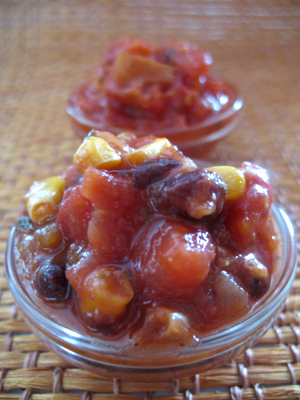 |


Salsa Bobos is laden with large chunks of tomato, black beans and kernels of corn. Behind it, Cowpoke Artichoke Salsa. Photo by Melody Lan | THE NIBBLE. |
| WHAT IT IS: Gourmet salsas. |
| WHY IT’S DIFFERENT: Twenty-three different flavors, mostly tomato-based, each truly different from the rest. |
| WHY WE LOVE IT: Top-quality ingredients and mouth-watering recipes. Plus, the wide range of choices means that no matter how much you love salsa, you’ll equally love the anticipation of discovering something new. |
| PURCHASE AT: JardineFoods.com. |
|
|
 |

Jardine’s Gourmet Salsa:
Salsa To Dance About
Page 2: Types Of Mexican Salsa
This is Page 2 of an eight-page review. Click on the black links below to visit other pages.
INDEX OF REVIEW
MORE TO DISCOVER
|
Types Of Mexican Salsa
Mexican salsas can be served fresh (uncooked) or cooked. They can be hot, spicy, sweet or tangy. Like the cuisine of any nation, the ingredients vary with regional availability and preferences. There are more than 30 chiles in Mexico: The chile of choice can be the mild, fruity ajis, the medium-spicy serranos, jalapeños and their smoked form, chipotles, or the hot-hot habañero. Seasonings can include cumin, herbs like cilantro and fresh lime juice. Add-ins vary widely as well. In the northern Mexican states, cooks use aji, annatto, avocado, cassava, chipotle, corn, cumin, fruit, habañero, jalapeño and salt cod.
Salsa Fresca
What many of us think of as salsa is salsa fresca or salsa cruda, a fresh sauce served as a condiment with a Mexican dish, or with a basket of tortilla chips at the beginning of the meal or at the bar. While there are many variations, a typical fresh salsa is made of chopped tomatoes, chiles and onions, generally seasoned with cilantro and lime juice. The degree of heat will vary.
The fresh red salsas are called salsa cruda, salsa fresca and pico de gallo, which are similar with small differences (see the Salsa Glossary for details). The tomatillo-based salsa verde is also a salsa fresca (although it can be cooked, too), as is guacamole, made with avocados, tomatoes, chiles, onions and cilantro.
Cooked Salsa
While fresh salsas use fresh tomatoes and fresh green chiles, cooked salsas use roasted tomatoes and roasted or dried chiles. When the sauce is jarred or canned, the ingredients must be cooked briefly at a high temperature to make the product shelf-stable. Canned salsas can be smooth or coarsely textured, thick or thin, mild or hot. A cooked salsa is different in texture from a fresh one, but it is no less delicious. In fact, cooking opens the door to a lot of creativity in the use of ingredients—like cooked beans, corn, artichokes and olives—that would not find their way into the classic fresh sauces.
Continue To Page 3: Varieties Of Jardine’s Salsa
Go To Articles Index Above
How Many Types Of Salsa Are There?
You’d Be Surprised!
See Our Salsa Glossary. |
FOR ADDITIONAL INFORMATION, special offers,
contests, opinion surveys, THE NIBBLE prior issues archive, product gift-finder and more,
visit the home page of TheNibble.com.
Do you have friends who would enjoy THE NIBBLE?
Click here to send them an invitation to sign up for their own copy.
|
ABOUT THE NIBBLE. THE NIBBLE™, Great Finds For Foodies™, is an online magazine about specialty foods and the gourmet life. It is the only consumer publication and website that focuses on reviewing the best specialty foods and beverages, in every category. The magazine also covers tabletop items, gourmet housewares, and other areas of interest to people who love fine food.
© Copyright 2004-2025 Lifestyle Direct, Inc. All rights
reserved. All information contained herein is subject to change at any time
without notice. All details must be directly confirmed with manufacturers, service
establishments and other third parties. The material in this newsletter may not
be reproduced, distributed, transmitted, cached, or otherwise used, except with
the prior written permission of Lifestyle Direct, Inc.
|
 |
|
 |